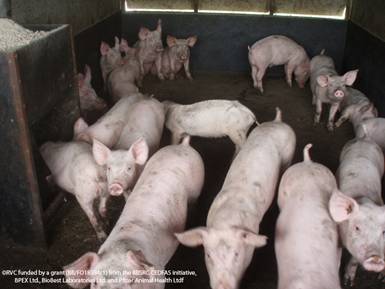Unit 3: PMWS - causes and predisposing factors
Post-weaning multi-systemic wasting syndrome was first described in 1996 in Canada from cases observed in 1991; similar problems were described in the US and Europe shortly after, and since then the disease has been reported worldwide.
As its name implies, PMWS typically affects growing pigs after weaning (aged between 7-15 weeks). There are no unique clinical signs for PMWS, but affected pigs can have fever, wasting (considerable weight loss can occur within 3-7 days), hairiness and enlarged lymph nodes. There is laboured breathing in more advanced stages and intermittent diarrhoea is occasionally seen.

Severe weight lost clearly seen in the pig at the centre of the pen
PMWS is caused by a virus known as Porcine Circovirus Type 2 (PCV-2). However, the virus can be present without triggering clinical signs and in fact it has been shown that PCV-2 can be isolated from diseased and healthy pigs/herds. In England, for instance, almost all pig farms were PCV-2 positive in 2008 and yet PMWS severity varied considerable with just 1 in every 5 farms being highly affected.
The virus (PCV-2) circulated on pig farms worldwide for many years before PMWS emerged as a recognised disease. So, apart from the virus what else is needed for PMWS to develop? PMWS is a multi-factorial disease, which means that other factors such as stress, other pathogens, genetics and/or farming practices are needed to trigger the disease. This section explains the interaction between these factors, based on present knowledge.